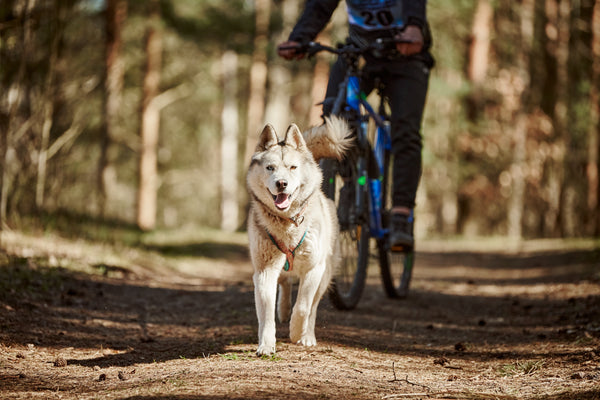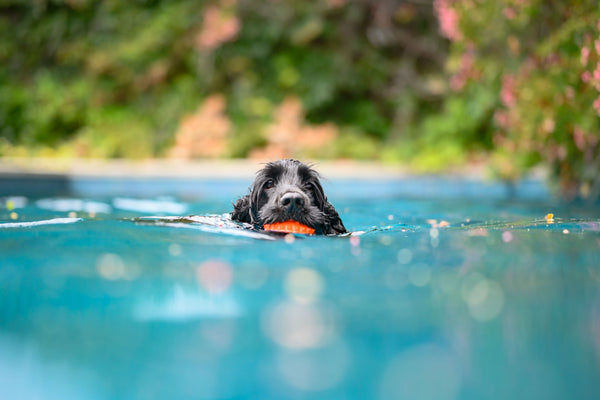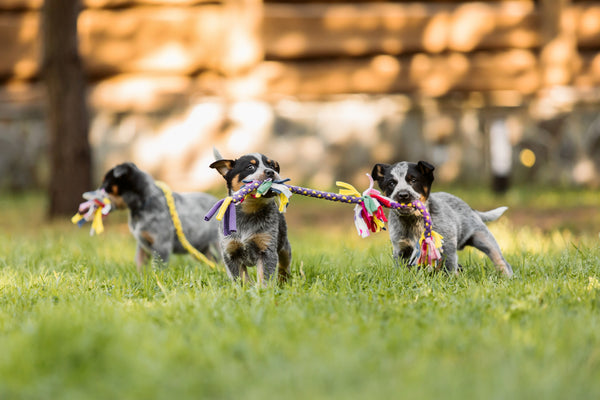Whether you're a newbie or an experienced pet parent, one question that always comes up for all pet owners is: how much exercise does my dog need? From dog yoga to dog sports, we all know that exercise is not only crucial for our furry companions' overall health but also a chance for you to bond with your pup.
However, it can be challenging to determine the right amount of physical activity for your pup. In this article, we'll explore the importance and health benefits of dog exercise and provide you with some tips to ensure an active lifestyle for you and your pup.
The Importance of Dog Exercise
Just like us humans, dogs need regular physical activity to stay fit and healthy. For many dogs, exercise is essential for maintaining their cardiovascular health, muscle strength, joint flexibility, and mental well-being.
Without enough exercise, our canine friends can face certain challenges. Moreover, exercise is also essential for keeping our dogs mentally stimulated. It helps them release pent-up energy and prevents destructive behaviors like chewing or excessive barking. Additionally, regular exercise can improve your dog's behavior and strengthen the bond between you two.

How Much Exercise Does Your Dog Need?
The amount of exercise your dog needs depends on various factors such as age, breed, size, and overall health.
Breed
Certain breeds require more exercise than others. For example, working or sporting breeds like Labrador Retrievers and Border Collies need at least an hour of vigorous exercise every day. On the other hand, other dogs like Chihuahuas may only need 20-30 minutes of lighter activity.
Age
Puppies have a lot of energy and need more frequent but shorter exercise sessions throughout the day. As they grow older, their exercise needs may decrease, but dog owners need to continue providing them with regular physical activity, as senior dogs encounter several health issues as they age.
Size
Larger breeds may require more exercise to stay healthy and maintain a healthy weight. However, it's crucial to monitor their activity levels and adjust accordingly to avoid overexertion. The suggested amount of exercise for small breeds is usually 30-40 minutes a day, while larger breeds may need up to an hour.
Health
If your dog has any health conditions, it's best to consult with your veterinarian on the appropriate amount and type of exercise. For example, dogs with joint problems may benefit from low-impact exercises like swimming or slow walks.
7 Tips for Keeping Your Dog Healthy and Active
Now that we've covered the importance of dog exercise, let's explore some tips to help you keep your furry friend happy and healthy:
Tip 1: Proper Nutrition
A well-balanced diet is crucial for your dog's energy levels and muscle maintenance. Consult with your veterinarian to ensure that you're feeding your pup the right amount of high-quality food based on their breed and age.
How can I give my dog proper nutrition?
- Feed your dog a diet that is appropriate for their age and size.
- Follow the recommended serving size on the food label and adjust as needed.
- Avoid giving your dog table scraps or too many treats, as this can lead to weight gain.
What are the best supplements to ensure proper nutrition?
- Omega-3 fatty acids for joint health and a shiny coat
- Probiotics for digestive health
- Multi-vitamin supplements for overall health and immunity
Tip 2: Regular Walks
Regular walks are an excellent form of exercise for most dogs. You can start with shorter walks and gradually increase the duration as your dog's fitness level improves. Don't forget to bring water and a poop bag on dog walks!
Tip 3: Playtime
Interactive play sessions with toys like balls or frisbees are not only great for exercise, but they also provide fun mental stimulation for your dog. Plus, it's an excellent opportunity to bond with your pup.

Tip 4: Swimming
Swimming is a great dog exercise, especially for canines with joint issues. However, not all dogs are natural swimmers, so make sure to introduce them to water gradually and always supervise them while swimming.
Tip 5: Mental Stimulation
In addition to physical activity, it's important to keep your dog mentally stimulated. You can do this by introducing new toys to pets or playing games like hide-and-seek with treats.
What are other ways I can mentally stimulate my dog?
You can help create mental challenges for your dog with fun games and activities such as:
- Training sessions: Teaching your dog new tricks or commands can be exciting for them.
- Puzzle toys: These types of toys require your dog to problem-solve and use their brain to figure out how to get a treat.
- Nose work: Dogs have an incredible sense of smell, and you can tap into this by hiding treats around the house or using a snuffle mat.
Tip 6: Consider Your Dog's Age and Health
As mentioned earlier, age and your dog's overall health play a significant role in determining your dog's exercise needs. Make sure to adjust their activity levels accordingly and always consult with your veterinarian before starting any new exercise routines.
Tip 7: Be Consistent
When it comes to your dog's exercise routine, consistency is key. Try to stick to a schedule and provide them with daily physical activity to keep them healthy and happy. If it's cold or rainy outside, incorporate indoor exercise to ensure consistency.
Ensuring Enough Exercise
So, how can you tell if your dog is getting enough exercise?
Here are some signs to look out for:
- Healthy weight: Your dog should have a visible waistline and be within the recommended weight range for their breed.
- Good behavior: Regular exercise can help reduce hyperactivity and promote calm behavior in dogs.
- Contentment: A well-exercised dog will often be content and relaxed when at home.
However, if you notice that your dog is gaining weight, has excess energy, or exhibits destructive behaviors, it may be a sign that they need more exercise.

Exercise Ideas for Different Dog Breeds
Low Energy Breeds
- Bulldog: Short walks and moderate play sessions are best for this breed.
- Basset Hound: Walks and short runs are ideal for these low-energy pups.
- Cavalier King Charles Spaniel: Moderate walks and play sessions suit this breed well.
- Pug: Short walks and indoor playtime are recommended for this breed.
- Greyhounds: Despite being known for their speed, greyhounds are often happy with a short daily walk.
- Shih Tzu: Regular walks or indoor play sessions can provide enough exercise for this breed.
- French Bulldog: These dogs have low energy levels and are not big on exercise, so short walks or play sessions are enough.
- Pekingese: Light walking or indoor play can meet the exercise needs of this breed.
- Boston Terrier: These compact dogs only need a moderate amount of daily exercise, so a few short walks will suffice.
- Bichon Frise: Moderate walks and occasional running sessions can keep these pups healthy and happy.
- Chihuahua: Short walks and indoor playtime can provide the right amount of exercise for this breed.
- Corgi: These energetic dogs need daily walks or runs to stay physically and mentally stimulated.
- Pomeranian: Regular short walks around the neighborhood are enough to keep this breed fit.
High Energy Breeds
- Border Collie: These dogs need plenty of physical and mental activity, including running, hiking, and agility training.
- Australian Shepherd: Daily walks and active play sessions are essential for this energetic breed.
- Siberian Husky: Huskies are known for their high energy levels and love long runs or hikes.
- Jack Russell Terrier: These small but mighty dogs need plenty of daily exercise, including walks and playtime.
- Vizsla: This breed loves to run and needs a lot of physical activity to stay healthy and happy.
- Dalmatian: An active breed that enjoys long runs or hikes with their owners.
- Weimaraner: These dogs need daily walks, playtime, and mental stimulation to stay happy and healthy.
- Labrador Retriever: Regular runs or swimming sessions are perfect for this energetic breed.
- Golden Retriever: These friendly dogs love long walks and can also enjoy activities like swimming or playing fetch.
- German Shepherd: This breed was originally bred for herding and needs plenty of daily exercise, including walks and runs.
Additional Considerations for Senior Dogs and Puppies
Senior Dogs
As dogs age, their exercise needs may change. It's essential to monitor and adjust their activity levels accordingly to avoid any injuries or health issues.
Some tips for exercising senior dogs include:
- Shorter walks: Elderly dogs may tire more quickly, so shorter walks multiple times a day may be better than one long walk.
- Low-impact activities: Swimming, dog yoga classes, gentle play sessions, and slow walks are ideal for senior dogs with joint issues.
- Veterinarian approval: Always consult with your veterinarian before starting any new exercise routines for your senior dog.
Puppies
Puppies also have different exercise needs compared to adult dogs. They have a lot of energy and need plenty of opportunities to run, play, and explore. However, it's crucial to avoid over-exercising them, as their joints are still developing.
Some tips for exercising puppies include:
- Shorter but frequent play sessions: Due to the short bursts of energy puppies have, it may be better to have multiple short play sessions throughout the day.
- Avoid high-impact activities: Jumping or running on hard surfaces can be harmful to a puppy's developing joints.
- Train with physical activity: Puppies can combine exercise and training through activities like obedience classes or agility training.
Conclusion
In conclusion, the amount of exercise your dog needs depends on many factors, such as breed, age, and health. Consider these factors when determining their exercise routine and always consult with your veterinarian for any concerns or questions.
By keeping your dog physically active, you are not only promoting their overall health but also strengthening the bond between you and your furry friend. So grab a leash and get moving – an active dog is a happy dog!














